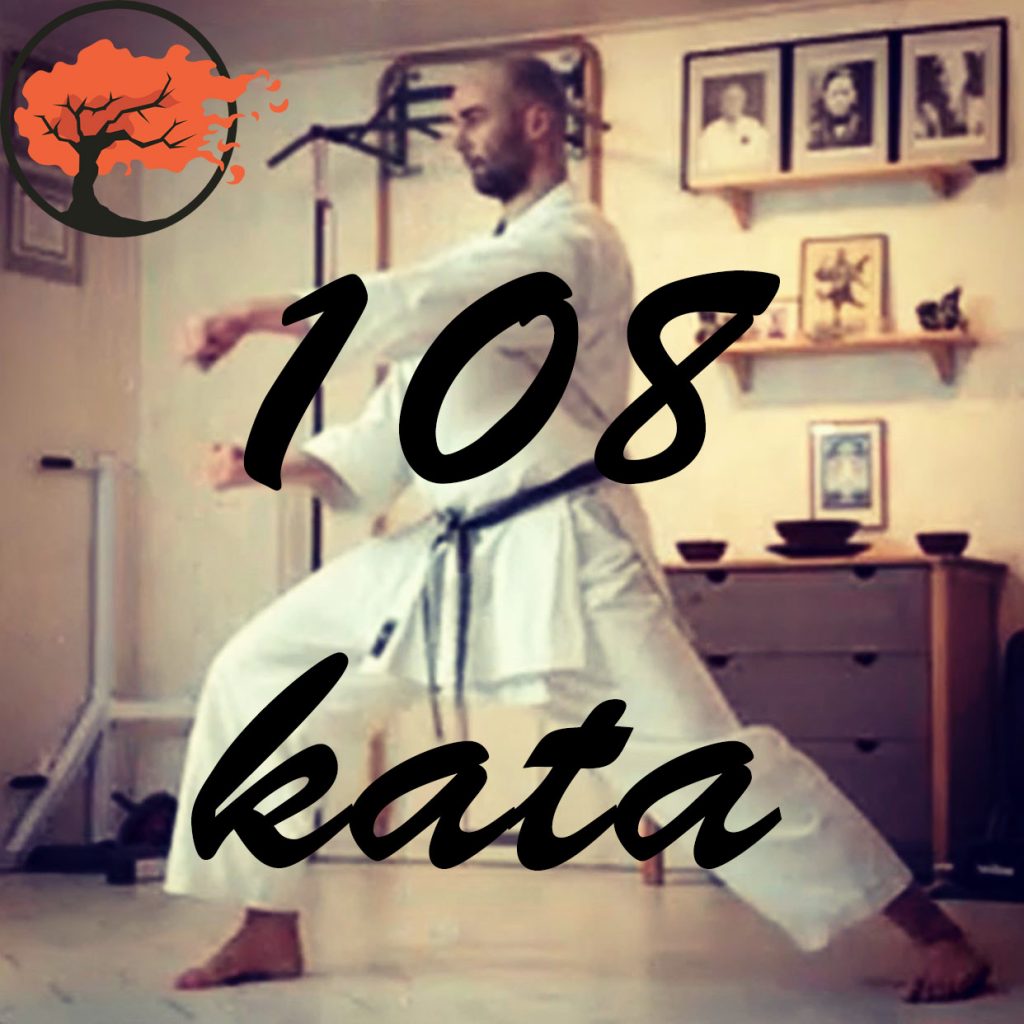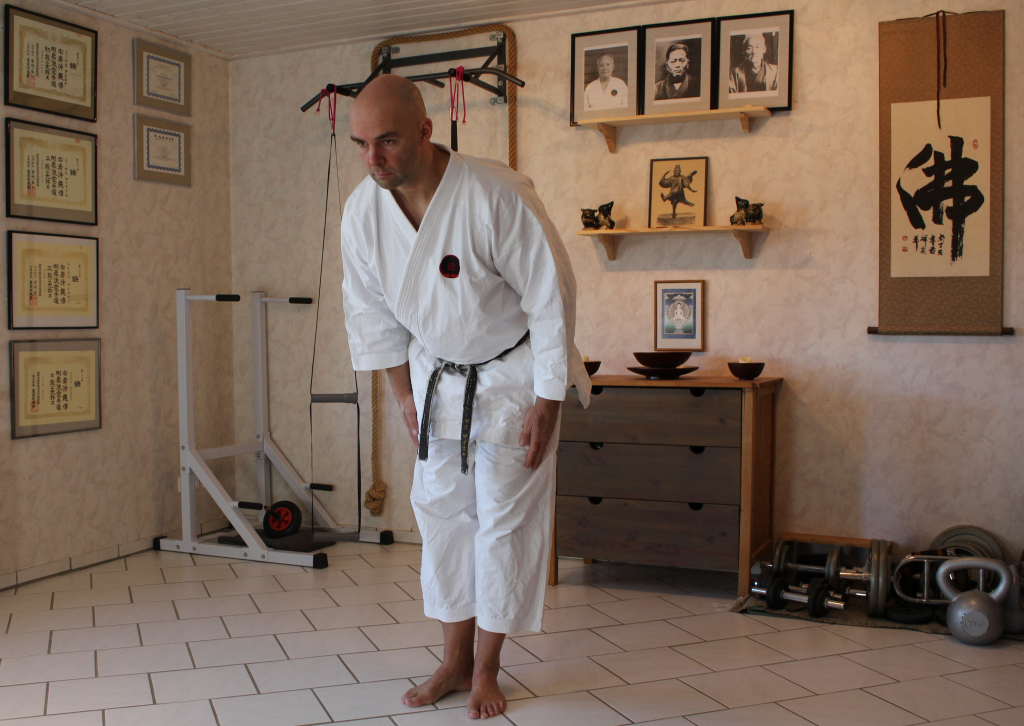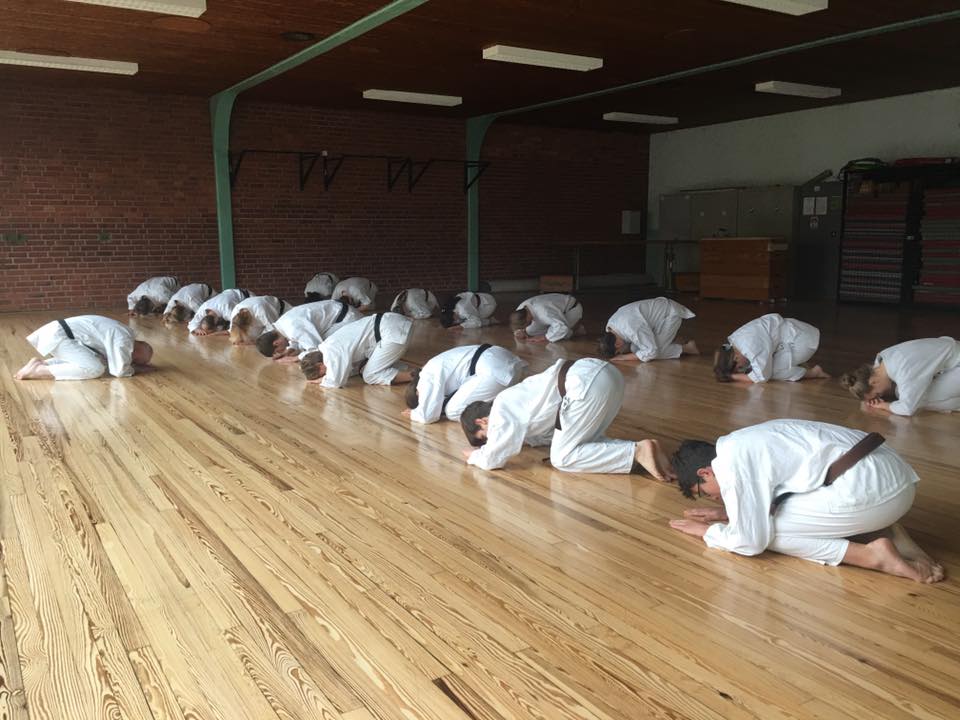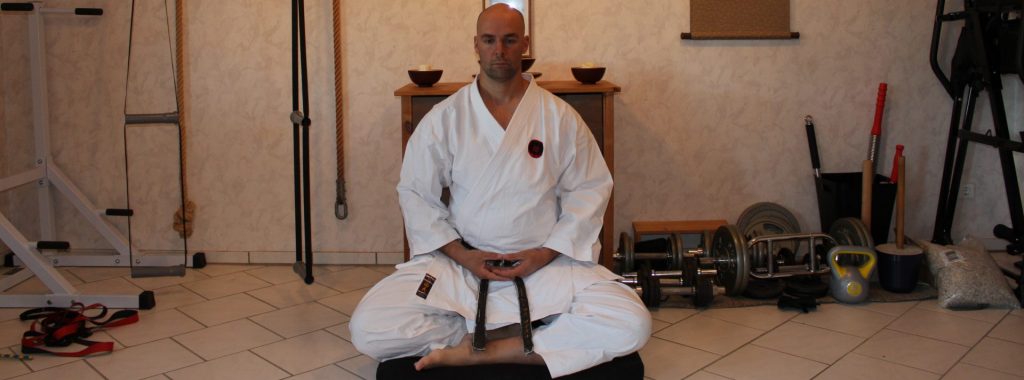
In the karate world knows an old tradition, the 108 kata challenge. Participants perform the same kata 108 times right one after another.
What is this for? Why 108? Doesn´t it get boring?
In the buddhist tradition several numbers have a certain meaning, those numbers can also be found in the kata and display a close connection between buddhism (primarily zen) and karate do. The number 108 has its roots in buddhism as well as in hinduism. In these teachings it appears in many contexts, from 108 ´stages of development´ to 108 ´disturbing emotions´. So this number is deeply anchored in religion, spirituality and culture of eastern Asia. A mala (a string with prayer beads), which is used, for example, to recite a mantra, has 108 beads. The practitioners use them for counting 108 repetitions while keeping their mind free and open with their exercise. If you train karate as a holistic martial art, it will pay off to have a closer look at this state of mind, especially when following the 108 kata tradition. The kata is a physical, but also mental and psychological exercise. Every small ritual has its purpose.

1.) Kio-tsu-ke, meaning “attention”, and literally meaning “collect your vital energy (Ki)”, is the beginning of the first or next kata. From this moment on the physical and mental kata-training starts (your mental training starts at least when you enter the dojo, your mental-physical training begins with junbi undo). For the whole the session the practitioner stays (all the 108 kata) in zanshin, which means ´remaining heart´. The state of zanshin is a continuous physical-mental presence, alertness and domination (terminology from Sensei Sydney Leijenhorst).
If the karateka has distracting thoughts or emotions, this is the time to let them go. Thoughts and emotions are of course a natural occurrence -even at this moment-, but we follow the zen proverb “…just don´t serve them tea.” and don´t hold on to or feed them with our mind. Instead we make them disappear with inobservance. So if we have got lost in thoughts and emotions, we now re-enter the “here and now”. If you have a hard time doing this, focus on your breath.

2.) Announcing the name of the kata clearly and loudly orients the karateka towards the action ahead. Through the intonation one´s own dedication and seriousness are getting clearly expressed. If the practitioner has gotten tired from all the kata before, the intonation can become a helpful way for self-motivation and mobilisation of energy, especially if spoken from the tanden (like the kiai).
3.) `Rei`: With the first bow and saying “onegai shimasu” (=”please help me”) we express our respect, humility and we ask for help. If we do this with devotion fully consciously, each single kata will become something special and ´sacred´to each one individually. Just remember that the kata is the main transmission of karate techniques we have. Like a samurai, who polishes his sword with veneration and who knows that his life depends on this sword, we polish our technique, mind and body with each single kata. We truly want the kata to help.

4.) A correct bow (rei) comes from your tanden with a straight spine. With this we show respect, but don´t degrade ourselves. A respectful inner and outer posture which doesn´t bring ourselves low, belongs to the characteristics that occur when you have been training karate for a while. So it is very helpful to bring this little ritual alive and fill it with awareness.
5.) With ´yoi´ (=”ready”) our line of sight keeps on eye level, the visual field opens up. We expand our “antenna”, our awareness, to notice everything around us (without looking around). The practitioner is wide awake and ready to be attacked, simultaneously rests in a calm state of mind. Between ´yoi´ and ´hajime´ there is a time span, during which we stay in ´mushin´ (=empty mind). It´s a period in which we are 100% ready, fully conscious in the here and now, ready to “unleash hell”. When I train with my students, this time span varies and the ´hajime´(=”start”) occurs all of a sudden with the aim to train this awareness. Physically, this state of mind gets anchored by breathing calmly into your tanden (=hara, vital point, center of gravity).

6.) During the practice of the kata the focus is held in the tanden. It is important not just to run through the kata (“run a kata”) but to keep one´s own grounding with each single step and technique. If you have been training the techniques often enough before, they are saved in your cerebellum and you don´t have to think about them in each single step. By doing so, the person exercising gets into a flow state more easily, can feel the tanden, grounding and energy more clearly and is able to readjust if needed. In this kata flow one is also more able to surrender to the hard and the soft parts and aspects as well as the spirit and temper of the kata.
7.) Finally, at the end of the kata, we keep our mindset and attitude as we keep our outer posture. We stay in zanshin. Fully conscious, with our line of sight at eye level, we turn back into musubi dachi. The hands return into yoi position. Your state of mind is the same as described in 5.), wide awake, sharp, open. Take your time for this. Human mankind witnessed quite some fights, in which the victor turned his/her back to the defeated person and finally got defeated him-/herself. After a real fight the human body contains a lot of adrenalin, the heart rate is high. It is crucial to train a proper mindset also after performing the kata, as we also have a higher heart rate at the end of it. In this moment of excitement you train yourself to actively calm down and you set up your inner karate anchor with tanden breathing, like you did in ´yoi´ at the beginning. If the person exercising has mentally dropped off during the kata, this is the right reminder to return back into the “here and now”, to be fully present and keep zanshin.
8.) The final rei, the bow, while saying ´arigato gozaimachita´(=”thank you very much”), displays respect and gratitude for the kata. This also should not be an empty gesture, give your best to consciously face this moment and feel the thankfulness, do it whole-heartedly. Thankfulness is closely related to humility and respect, our egos don´t like it. It is really worth practicing this 108 times and not to slur over it. The kata can be compared to an old script that is presented to you. It contains help for you to possibly save your life. Embody your gesture of thankfulness!
9.) All these small rituals require mindfulness. If we lose it in between, they are perfect reminders to get back into the “here and now”, to come back into zanshin. Train your mind by keeping zanshin throughout the whole 108 kata practice! It is best to remain in heiko dachi , breathe in through the nose into your tanden, breath out through your mouth between two kata. Sink into your center of gravity, relax as if you were sitting on a barstool, with a straight spine, sight line on eye level, internal yoi attitude.

Peña Chödrön, a spiritual student of the buddhist teacher Chögyam Trungpa, compares the meditation practice in one of her books to sitting on embers. The mind wants to break out, looks for possible distractions just to escape the intensity of this moment, even when you just sit on a meditation cushion. Doing the 108 kata can be a similar experience, so we are really training the mind by keeping zanshin. Sensei Paolo Spongia, during a ken zen ichinyo (=karate-zen-seminar), once said that we have a kind of responsibility for the other group members when practicing zazen (sitting zen meditation) with others. By sitting still on your cushion you encourage others to also stay on track. The 108 kata practice is similar. Your zanshin also affects the others, you help them by being a role model. So when you practice with your dojo community or even online with fellow karateka, be responsible for your own best practice and also for the others´.

So finally, if you are planning to do a 108 kata session, I hope I have been able to inspire you to replace some empty gestures here and there with movements that come from your tanden and heart. Act as a whole human, as one who is good and keeps improving, both internally and physically. When there are kids joining the session, or beginners, some ´entertainment´may be helpful to keep them going. Measuring the time needed, setting up new time records, putting variations into the kata, socializing etc. may help them to endure it physically.
But if you have read this post until here I assume you are more advanced. For you the time needed or games played along should not have any significance. A kata has to be performed correctly both physically and mentally. That´s the only criterion. Take the time you need to stay in zanshin. If you just close your eyes and run through, you will dodge the main exercise. A kata is not a race, it´s not made for this. So stay strong, don´t watch out for distractions, don´t set up false goals, awaken the warrior within yourself and follow the whole, holistic path!
„Train your mind and body.“ (Dojokun)
Thank you very much for reading this article. I personally want to thank Sensei Sydney Leijenhorst (chief instructor of the Netherlands, IOGKF) and Sensei Paolo Spongia (chief instructor of Italy, zen teacher) for their many inspirations during the last decades, which led me to write this post. If you have a chance to learn from them, use it! In the video-course of this web site we also deepen the internal practice, especially in a 9-week-meditation course you find there. Mental-physical challenges can also be found on the free conten site here.

If you liked the content, please feel free to share it! You can also subscribe to my newsletter (no spam, it is released quite rarely) if you don´t want to miss the next blog articles.

One thought on “9 points to embody if you want to make the most of your 108 kata challenge:”
Hi Thomas, sehr schön auf den Punkt gebracht. Ich habe schon am Freitag bei der 108er kata challenge wieder einiges gelernt über mich und mein Karate. Mit jedem 108er komme ich ein Stück weiter. Dein Post hat dies noch einmal in einigen Punkten verdeutlicht. Wichtig finde ich den persönlichen Rhythmus zufinden, der m.E. auch variieren darf. Danke dafür.